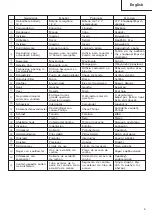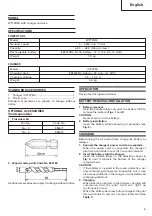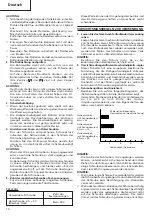
English
9
5. Number of screws tightenings possible
Please refer to the table below for the number of
screw tightened possible with one charge.
EB1220BL
These values may vary slightly, according to
surrounding temperature and battery characteristics.
OPERATIONAL CAUTIONS
1. Resting the unit after continuous work
After use for continuous screw-tightening work, rest
the unit for 15 minutes or so when replacing the
battery. The temperature of the motor, switch, etc.,
will rise if the work is started again immediately after
battery replacement, eventually resulting in burnout.
NOTE:
Do not touch the protector, as it gets very hot during
continuous work.
2. Cautions on use of the speed control switch
This switch has a built-in, electronic circuit which
steplessly varies the rotation speed. Consequently,
when the switch trigger is pulled only slightly (low
speed rotation) and the motor is stopped while
continuously driving in screws, the components of
the electronic circuit parts may overheat and be
damaged.
3. Screw sizes and tightening times
Refer to the following diagram below which indicates
screw sizes and tightening times.
Use these tightening times as a preliminary estimate,
since they may vary due to the hardness of the wood,
ambient temperatures and the properties of the
rechargeable batteries, etc.
NOTE:
The sizes of the screws which can be tightened will
vary according to the wood. Therefore, test-tighten a
few screws before doing the actual tightening to
verify whether or not they can be tightened.
NOTE:
䡬
If a long striking time is used, screws will be strongly
tightened. This may cause the screw to break, or may
damage the tip of the bit.
䡬
If the unit is held at an angle to the screw being
tightened, the head of the screw may be damaged, or
the specified torque may not be transmitted to the
screw. Always keep the unit and the screw being
tightened in a straight line.
4. Use bits which match the screw's diameter
Be careful to not damage the heads of the screws by
using bits which do not match the screw's diameter.
5. Holding the tool
Hold the oil pulse driver firmly with both hands. In
this case hold the driver in line with the screw.
It is not necessary to push the driver very hard. Hold
the driver with a force just sufficient to counteract the
pulse force.
FEATURES OF THE CORDLESS OIL PULSE
DRIVER
The oil pulse driver is a hydraulic impact driver that
uses oil viscosity to generate pressure for the
tightening of screws. Due to the usage of this method,
the noise that is generated when screws are being
tightened has been greatly reduced in comparison to
that of other impact drivers. In contrast though, the
inherent reverberations of the oil pulse are greater in
comparison to those of impact drivers, so firmly
steady the tool.
NOTE:
Since the viscosity of the oil will vary according to
the temperature, pay heed to the following points in
using the tool.
䡬
Avoid using the tool below temperatures of - 5°C.
If the tool is used in temperatures below - 5°C, no
torque may be generated even when it is switched
on, or the torque may be seriously reduced so that
the tool becomes overloaded which may lead to the
motor being damaged.
䡬
For continuous operations, no more than two batteries
should be used.
If the tool is operated continuously so that it becomes
excessively hot due to nonstop operations, the torque
will abruptly increase making it difficult to tighten the
screws.
If this situation occurs, shut the tool off and let it rest
for a half an hour or more.
MAINTENANCE AND INSPECTION
1. Inspecting the driver bit
Using a broken bit or one with a worn out tip is
dangerous because the bit can slip. Replace it.
2. Inspecting the mounting screws
Regularly inspect all mounting screws and ensure
that they are properly tightened. Should any of the
screws be loose, retighten them immediately. Failure
to do so may result in serious hazard.
3. Maintenance of the motor
The motor unit winding is the very "heart" of the
power tool.
Exercise due care to ensure the winding does not
become damaged and/or wet with oil or water.
Screw used
No. of tightenings
Wood screw ø4
×
50
Approx. 530
(Soft wood)
Wood screws
(with cutting edges)
4mm
×
50
Wood screws
(with cutting edges)
4.2mm
×
75
Wood screws
(with cutting edges)
4.2mm
×
90
Materials: Treated hemlock
(western) spruce
Tightening times (seconds)
0
1
2
3
4
Содержание WP 12DM
Страница 57: ...56 ...
Страница 60: ...59 ...
Страница 62: ...61 1 2 3 4 5 ...
Страница 63: ...62 ...
Страница 64: ...63 ...











































